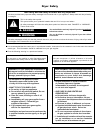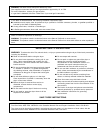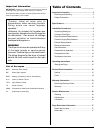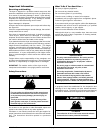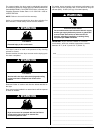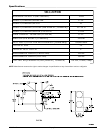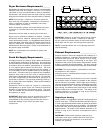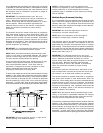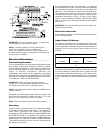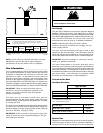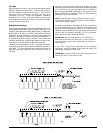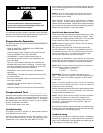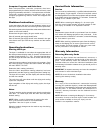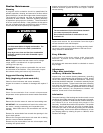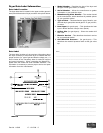
10 Maytag Co. 113062-17
It is suggested that the ductwork from each dryer not exceed
10 feet with no more than two elbows. If the ductwork exceeds
10 feet or has numerous elbows, the cross-sectional area of
the ductwork must be increased in proportion to length or
number of elbows in it.
IMPORTANT: For extended ductwork runs, the cross-
sectional area of the ductwork can only be increased to an
extent. Maximum proportional ductwork runs cannot
exceed 10 feet more than the original limitations of 10 feet
with two elbows. When the ductwork approaches the
maximum limits as noted in this manual, a professional
HVAC firm should be consulted for proper venting
information.
The ductwork should be smooth inside with no projections
from sheet metal screws or other obstructions, which will
collect lint. When adding ducts, the duct to be added should
overlap the duct to which it is to be connected. All ductwork
joints must be taped to prevent moisture and lint from
escaping into the building. Also, inspection doors should be
installed at strategic points in the exhaust ductwork for
periodic inspection and cleaning.
IMPORTANT: It is recommended that exhaust or booster
fans not be used in the exhaust ductwork system.
NOTE: When the exhaust ductwork passes through a wall,
ceiling, or roof made of combustible materials, the opening
must be 2-inches larger than the duct (all the way around).
The duct must be centered within this opening.
As per the National Fuel Gas Code, “Exhaust ducts for type
2 clothes dryers shall be constructed of sheet metal or
other noncombustible material. Such ducts shall be
equivalent in strength and corrosion resistance to ducts
made of galvanized sheet steel not less than
26 gauge (0.0195-inches [0.50 mm]) thick.”
To protect the outside end of the horizontal ductwork from the
weather, a 90° elbow bent downward should be installed
where the exhaust exits the building. If the exhaust ductwork
travels vertically up through the roof, it should be protected
from the weather by using a 180° turn to point the opening
downward. In either case, allow at least twice the diameter
of the duct between the duct opening and nearest obstruction.
IMPORTANT: Do not use screens, louvers, or caps on the
outside opening of the exhaust ductwork.
NOTE: In situations where a 10-inch exhaust duct is
required or acceptable, to ease installation an 8-inch dryer
exhaust outlet size to 10-inch exhaust duct increaser
(transition piece) is available from the factory by ordering
Part No. 882099.
Multiple Dryer (Common) Venting
If it is not feasible to provide separate exhaust ducts for each
dryer, ducts from individual dryers may be channeled into a
common main duct. The individual ducts should enter the
bottom or side of the main duct at an angle not more than 45°
in the direction of the airflow.
IMPORTANT: No more than eight dryers should be
connected to one main common duct.
NOTE: Refer to the illustration on the next page for
examples of multiple dryer (common) venting.
The main duct may be any shape so long as the minimum
cross-sectional area is provided. The illustration on the next
page shows the minimum cross-sectional area for multiple
dryer venting. These figures must be increased in proportion
if the main duct run from the last dryer to where it exhausts to
the outdoors is unusually long (over 20 feet) or has numerous
elbows (more than one) in it.
IMPORTANT: For extended ductwork runs, the cross-
sectional area of the ductwork can only be increased to an
extent. Maximum proportional ductwork runs cannot
exceed 20 feet more than the original limitations of 20 feet
with one elbow. When the ductwork approaches the
maximum limits as noted in this manual, a professional
HVAC firm should be consulted for proper venting
information.
Exhaust back pressure measured by a manometer at the
dryer’s exhaust duct area must be no less than 0 and must
not exceed 0.3 in wc when both tumblers are operating.
The ductwork should be smooth inside with no projections
from sheet metal screws or other obstructions, which will
collect lint. When adding ducts, the duct to be added should
overlap the duct to which it is to be connected. All ductwork
joints must be taped to prevent moisture and lint from
escaping into the building. Also, inspection doors should be
installed at strategic points in the exhaust ductwork for
periodic inspection and cleaning.
NOTE: When the exhaust ductwork passes through a wall,
ceiling, or roof made of combustible materials, the opening
must be 2-inches larger than the duct (all the way around).
The duct must be centered within this opening.
To protect the outside end of the horizontal ductwork from the
weather, a 90° elbow bent downward should be installed
where the exhaust exits the building. If the exhaust ductwork
travels vertically up through the roof, it should be protected
from the weather by using a 180° turn to point the opening
downward. In either case, allow at least twice the diameter
of the duct between the duct opening and nearest obstruction.



